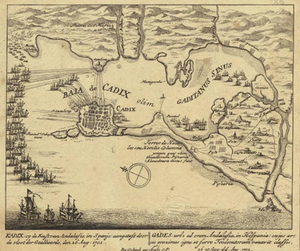Battle of Cadiz (1702)
| Battle of Cádiz | |||||||
|---|---|---|---|---|---|---|---|
| Part of the War of the Spanish Succession | |||||||
 Contemporary map of the Battle of Cádiz 1702. |
|||||||
|
|||||||
| Belligerents | |||||||
|
|
|
||||||
| Commanders and leaders | |||||||
|
|
|
||||||
| Strength | |||||||
| ~1,000 regulars Several thousand militia |
50 ships:
|
||||||
50 ships:
The Battle of Cádiz, fought in August/September 1702, was an Anglo-Dutch attempt to seize the southern Spanish port of Cádiz during the War of the Spanish Succession. The Andalusian city of Cádiz was the great European centre of the Spanish–American trade. The port’s capture would not only help to sever Spain’s links with her empire in the Americas, but it would also provide the Allies with a strategically important base from which the Anglo-Dutch fleets could control the western Mediterranean Sea.
The military build-up was accompanied by diplomatic measures in Portugal aimed at securing King Peter II for the Grand Alliance. The Allies also intended to garner support in Spain for an insurrection in the name of the Austrian pretender to the Spanish throne, the Archduke Charles. The battle was the first of the war in the Iberian Peninsula, but due to Allied intra-service rivalry, ill discipline, poor co-operation, and a skilful defence from the Marquis of Villadarias, Admiral George Rooke was unable to complete his objective and, after a month, he set sail for home.
On 15 May 1702 the Powers of the Grand Alliance, led by England and the Dutch Republic, declared war on France and Spain. Emperor Leopold I also declared war on the Bourbon powers, but his forces under Prince Eugene had already begun hostilities in northern Italy along the Po Valley in an attempt to secure for Austria the Spanish Duchy of Milan. Eugene’s successful 1701 campaign had aroused enthusiasm in England for war against France, and helped Emperor Leopold’s efforts in persuading King William III to send an Allied fleet to the Mediterranean Sea. Count Wratislaw, the Emperor’s envoy in England, urged that the sight of an Allied fleet in the Mediterranean would effect a revolution in the Spanish province of Naples; win south Italy from the precarious grip of Philip V; overawe the Francophile Pope Clement XI; and encourage the Duke of Savoy – and other Italian princes – to change sides. More modestly, Prince Eugene pleaded for a squadron to protect the passage of his supplies from Trieste across the Adriatic.
...
Wikipedia
